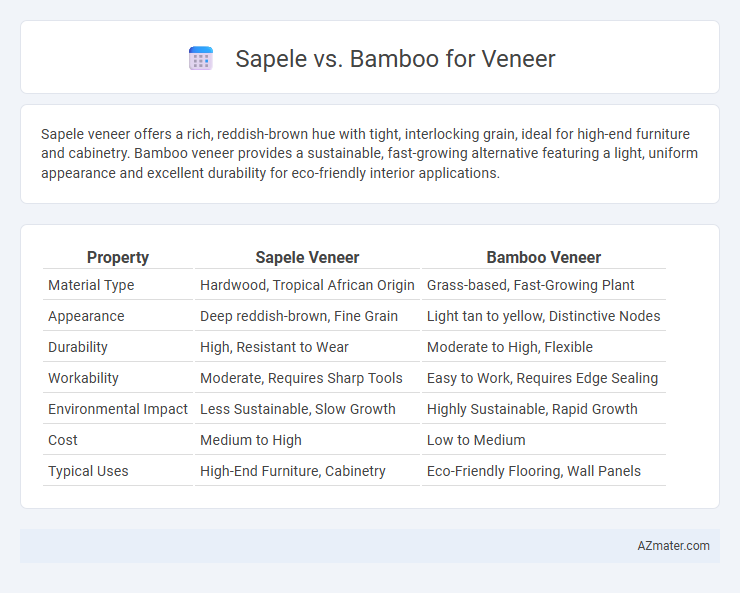Sapele veneer offers a rich, reddish-brown hue with tight, interlocking grain, ideal for high-end furniture and cabinetry. Bamboo veneer provides a sustainable, fast-growing alternative featuring a light, uniform appearance and excellent durability for eco-friendly interior applications.
Table of Comparison
| Property | Sapele Veneer | Bamboo Veneer |
|---|---|---|
| Material Type | Hardwood, Tropical African Origin | Grass-based, Fast-Growing Plant |
| Appearance | Deep reddish-brown, Fine Grain | Light tan to yellow, Distinctive Nodes |
| Durability | High, Resistant to Wear | Moderate to High, Flexible |
| Workability | Moderate, Requires Sharp Tools | Easy to Work, Requires Edge Sealing |
| Environmental Impact | Less Sustainable, Slow Growth | Highly Sustainable, Rapid Growth |
| Cost | Medium to High | Low to Medium |
| Typical Uses | High-End Furniture, Cabinetry | Eco-Friendly Flooring, Wall Panels |
Introduction: Sapele vs Bamboo Veneer
Sapele veneer, derived from the tropical African mahogany tree, is prized for its rich reddish-brown color, durability, and fine interlocking grain, making it a popular choice in high-end furniture and cabinetry. Bamboo veneer, harvested from fast-growing bamboo stalks, offers a sustainable, eco-friendly alternative with a distinctive linear grain pattern and impressive strength. Comparing Sapele and Bamboo veneers highlights differences in aesthetics, environmental impact, and material properties crucial for designers and manufacturers selecting materials for veneer applications.
Botanical Origins and Growth Patterns
Sapele veneer originates from the Sapele tree (Entandrophragma cylindricum), a hardwood species native to tropical Africa, characterized by its slow growth in dense, evergreen forests. Bamboo veneer is derived from the fast-growing, grass family species (Poaceae), primarily cultivated in Asia and known for its rapid maturation, reaching harvest size within 3 to 5 years. The contrasting botanical origins and growth patterns influence their structural properties, with Sapele exhibiting tight grain and durability, while bamboo offers flexibility and sustainability due to its rapid regeneration.
Appearance and Grain Characteristics
Sapele veneer features a rich reddish-brown color with subtle interlocking grain patterns, offering a smooth, reflective surface that enhances elegance in woodworking projects. Bamboo veneer displays a lighter, natural tan hue with a distinctive linear grain characterized by nodes and thin stripes, providing a contemporary and uniform look. The choice between Sapele and Bamboo veneers depends on the desired aesthetic, with Sapele providing warm, traditional appeal and Bamboo delivering a modern, eco-friendly texture.
Color Variations and Visual Appeal
Sapele veneer showcases rich reddish-brown hues with subtle interlocking grain patterns that deepen over time, providing a warm, luxurious aesthetic ideal for high-end furniture and cabinetry. Bamboo veneer offers lighter, golden tones with linear, uniform grain patterns, creating a modern, eco-friendly look that complements contemporary designs. The contrasting color variations and textures make Sapele suitable for traditional elegance, while Bamboo stands out in minimalist and sustainable decor projects.
Durability and Hardness Comparison
Sapele veneer exhibits higher durability and hardness compared to bamboo veneer, making it ideal for heavy-use applications. Sapele's Janka hardness rating averages around 1,410 lbf, indicating substantial resistance to wear and denting, whereas bamboo typically scores around 1,300 lbf but varies significantly by processing method. The dense grain structure of Sapele enhances its longevity, while bamboo's hardness can fluctuate based on treatment and strand orientation, affecting overall performance in veneer products.
Sustainability and Environmental Impact
Sapele veneer, sourced from slow-growing African mahogany trees, often raises concerns due to deforestation risks and longer regeneration periods, impacting sustainability negatively compared to bamboo. Bamboo veneer offers superior environmental benefits because it is a fast-growing grass that can be harvested every 3-5 years without replanting, significantly reducing habitat destruction and carbon footprint. Additionally, bamboo's ability to sequester more CO2 and its high renewability make it a more eco-friendly choice for sustainable woodworking projects.
Cost and Market Availability
Sapele veneer typically costs more due to its rich, reddish-brown color and durability, making it a premium choice in woodworking and furniture industries. Bamboo veneer offers a more cost-effective alternative with faster renewability and widespread availability, appealing to environmentally-conscious markets and budget-sensitive projects. Market availability favors bamboo globally because of its rapid growth and sustainable harvesting, whereas Sapele is regionally sourced primarily from West Africa, sometimes resulting in higher procurement costs and limited supply.
Applications in Interior Design
Sapele veneer offers rich reddish-brown hues and fine grain patterns ideal for upscale cabinetry, furniture, and wall paneling, enhancing luxury interiors with warm, classic aesthetics. Bamboo veneer provides sustainable, lightweight surfaces with distinctive linear patterns, perfect for modern flooring, cabinetry, and wall coverings that emphasize eco-friendly design. Both materials contribute unique textures and durability suited for diverse interior design styles, balancing elegance and sustainability.
Maintenance and Longevity
Sapele veneer boasts high durability and low maintenance requirements due to its dense grain structure and natural resistance to wear and moisture. Bamboo veneer, while eco-friendly and visually appealing, requires more frequent sealing and careful moisture management to prevent swelling and discoloration over time. Sapele's superior hardness and stability contribute to its longer lifespan compared to bamboo in veneer applications.
Final Verdict: Choosing Between Sapele and Bamboo Veneer
Sapele veneer offers a rich, reddish-brown hue with intricate grain patterns, making it ideal for luxury furniture and cabinetry, while bamboo veneer provides a sustainable, eco-friendly alternative featuring a lighter color and uniform texture. Durability and moisture resistance are higher in bamboo, suited for contemporary and high-humidity environments, whereas Sapele excels in classic aesthetics and fine woodworking applications. The final choice depends on project goals: select Sapele for traditional elegance and warmth, or bamboo for sustainability and modern, durable design.

Infographic: Sapele vs Bamboo for Veneer
 azmater.com
azmater.com